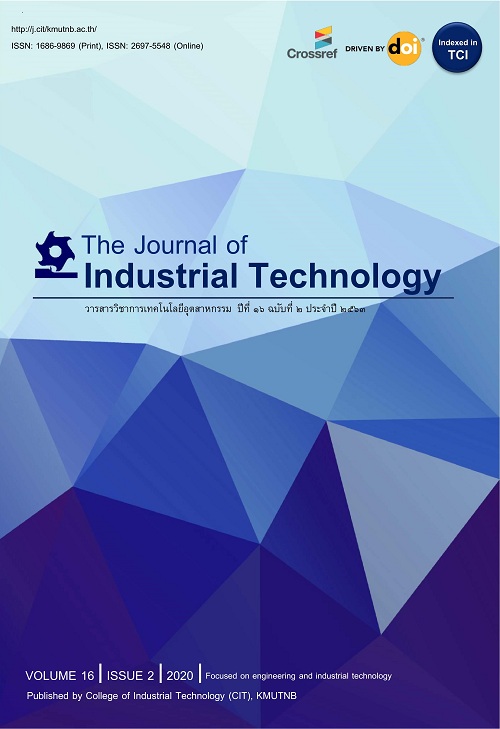Development of Standard System Integration Process for the Automotive Industry
การพัฒนากระบวนการบูรณาการระบบมาตรฐานสำหรับอุตสาหกรรมยานยนต์
Abstract
การศึกษานี้มีวัตถุประสงค์ (1) เพื่อพัฒนากระบวนการบูรณาการข้อกำหนดของระบบมาตรฐานสำหรับอุตสาหกรรมยานยนต์ และ (2) เพื่อพัฒนาคู่มือการบูรณาการข้อกำหนดสำหรับระบบบริหารงานคุณภาพของอุตสาหกรรมยานยนต์กับระบบการจัดการสิ่งแวดล้อมและระบบการจัดการอาชีวอนามัยและความปลอดภัย โดยใช้การศึกษาและพัฒนากระบวนการแบบผสมผสานเชิงคุณภาพและเชิงปริมาณ เป็นการศึกษาและวิเคราะห์ข้อมูลเกี่ยวกับอุตสาหกรรมยานยนต์และข้อกำหนดของระบบมาตรฐาน เพื่อนำมาพัฒนากระบวนการโดยจัดทำเป็นคู่มือการบูรณาการข้อกำหนดสำหรับระบบ ผลการพัฒนากระบวนการและคู่มือการบูรณาการข้อกำหนดของระบบมาตรฐานสำหรับอุตสาหกรรมยานยนต์ประกอบด้วย การจัดทำโครงสร้างองค์กร การเปรียบเทียบข้อกำหนด การกำหนดหน้าที่ความรับผิดชอบ การกำหนดรายการเอกสาร และการสร้างแบบฟอร์มควบคุมเอกสาร จากนั้น ทำการตรวจสอบคุณภาพของกระบวนการและคู่มือฉบับร่างโดยผู้เชี่ยวชาญ 5 ท่าน ผลการประเมินคุณภาพได้คะแนน 4.60 ซึ่งจัดอยู่ในระดับมีคุณภาพดีมากที่สุด ผลการศึกษาพบว่า ก่อนการบูรณาการระบบมีเอกสารทั้งหมด 79 คู่มือ 358 แบบฟอร์ม หลังจากบูรณาการระบบคงเหลือ 36 คู่มือ 154 แบบฟอร์ม ซึ่งมีเอกสารลดลงจำนวน 43 คู่มือ คิดเป็น 54.43% และ 204 แบบฟอร์ม คิดเป็น 56.98% ซึ่งช่วยประหยัดค่าใช้จ่ายและลดระยะเวลาในการดำเนินการระบบ ส่งผลให้พนักงานในองค์กรเข้าใจระบบได้ง่ายขึ้น และปฏิบัติในแนวทางเดียวกันทั้งองค์กร
This study aimed to (1) develop a process for integrating the requirements of the system for the automotive industry and (2) develop a manual on integrating the requirements for the Automotive Quality Management System with the Environmental Management System and the Occupational Health and Safety Management System. The study and development of a qualitative and quantitative blended application process, which is a study involved a review and analysis of information about the automotive industry, and standard system requirements. To be used to develop the process by creating a manual for integrating system requirements. The results of the process development and the system requirements integration manual for the automotive industry consisting organizational structure, comparison of requirements, defining responsibilities, document list, and creation of document control forms. The quality of the process and the draft manual were then evaluated by five experts. The quality evaluation results were 4.60, which was considered the highest quality level. The results of the study found that before the system integration, documents there were 79 manuals 358 forms. After the system integration, there were 36 manuals 154 forms. These found the documents reduced by 43 manuals or 54.43%, and 204 forms or 56.98%.Saving cost and shortening the duration of system implementation. As a result, employees in the organization can understand the system more easily, and operate in the same way throughout the organization.
Keywords
[1] https://www.youtube.com/channel/UCor-UDN-fElmnuZHBcOJQdw/videos. (Accessed on 29 April 2021)
[2] K. Wongkhan, Research and development model (R&D) and participatory action research model (PAR), Ubon Ratchathani University, 2018. Available: https://www.ubu.ac.th/web/files_up/08f2018072012262188.pdf. (in Thai)
[3] A. Huttametta, Integrated management system manual for ISO 9001:2000, ISO 14001:2004 and OHSAS 18001:2007, Independent Study, Sukhothai Thammathirat Open University, Thailand. 2008.
[4] M. Ćurčić, S. Petronić, Đ. Katnić, R. Balic, and D.D. Milovanović, Establishing integrated management system (IMS) through integration of standard ISO 9001, ISO 14001 and ISO 45001 in the scientific department of Institute of Nuclear Science ‘VINCA’, International Journal of Advanced Quality, 2018, 46(3-4), 40-45.
[5] W. Nuntakasikorn, Handbook on occupational health and safety management system (ISO 45001:2018) for pest control services, Independent Study, Sukhothai Thammathirat Open University, Thailand. 2020.
[6] O. Thipchaksurat, Guidelines for improving environmental management system ISO 14001:2004 towards ISO 14001:2015 in an electronics factory, Independent Study, Sukhothai Thammathirat Open University, Thailand. 2015.
[7] S. Sanorlam, Integrated quality safety and Environmental management system for concrete roof manufacturer, Thesis, Chulalongkorn University, Thailand. 2016.
[8] S. Chanprateep, Improvement of document system control for ISO/TS 16949, ISO 9001 and ISO 14001 in polyurethane foam industry, Thesis, Chulalongkorn University, Thailand. 2006.
[9] R. Uriarte-Romero, M. Gil-Samaniego, E. Valenzuela-Mondaca, and J. Ceballos-Corral, Methodology for the successful integration of an energy management system to an operational environmental system, The Journal of Sustainability, 2017, 9(8), 1304.
[10] Y. Pratikno, The advantages of implementation of integrated management system on ISO 45001 and ISO 14001 in manufacturing industry, Dinasti International Journal of Digital Business Management, 2020, 1(3), 423-433.
[11] J. Jiaranaimanee, A feasibility study of integration of ISO 14001 and TIS 18001 with ISO 9001 in Berli Jucker Cellox Limited Prachin Buri, Thesis, National Institute of Development Administration, Thailand. 2009.
[12] R. Wongmaneethet, Checklists and tools for internal audit of environment management system ISO 14001:2004 integrate with quality management system ISO 9001:2008, Independent Study, Sukhothai Thammathirat Open University, Thailand. 2008.DOI: 10.14416/j.ind.tech.2022.04.005
Refbacks
- There are currently no refbacks.






